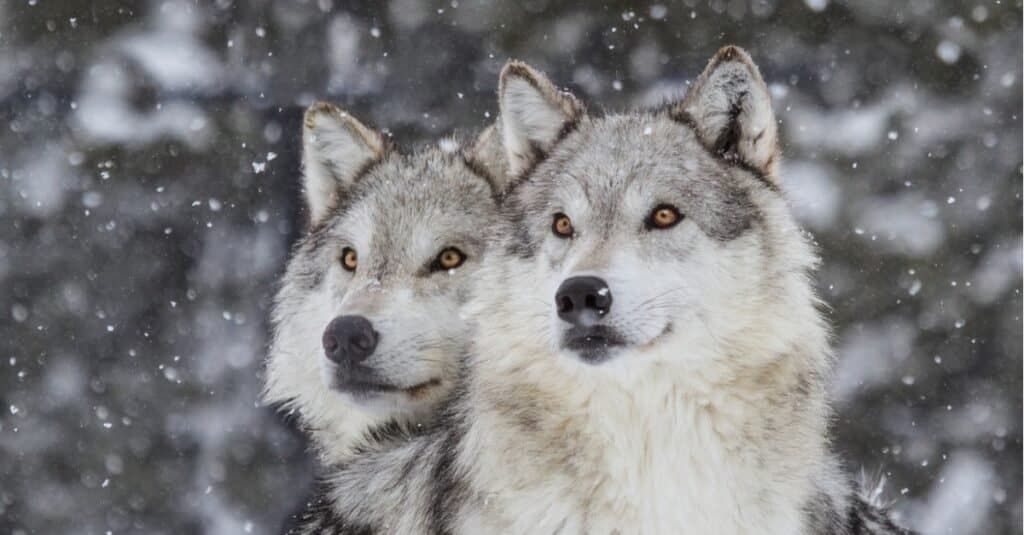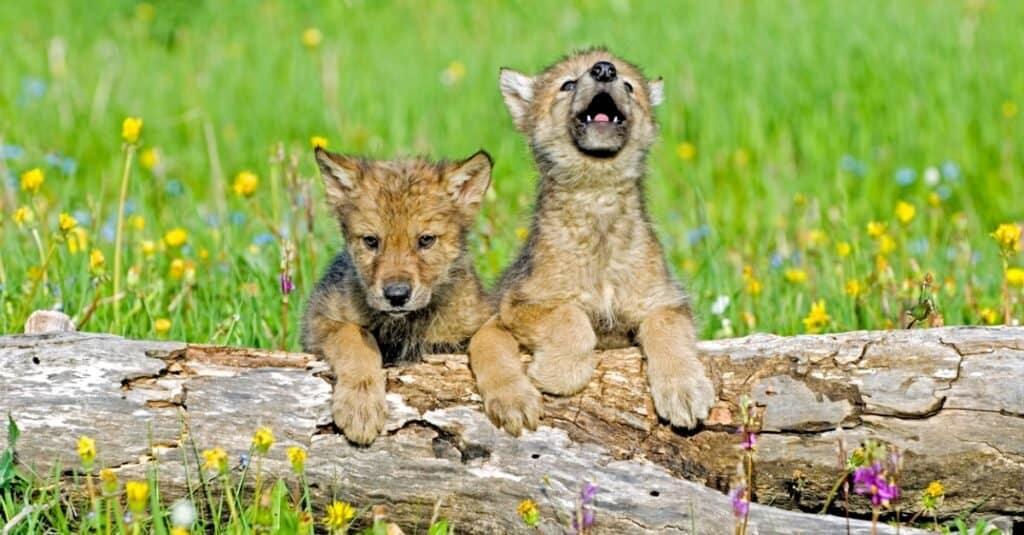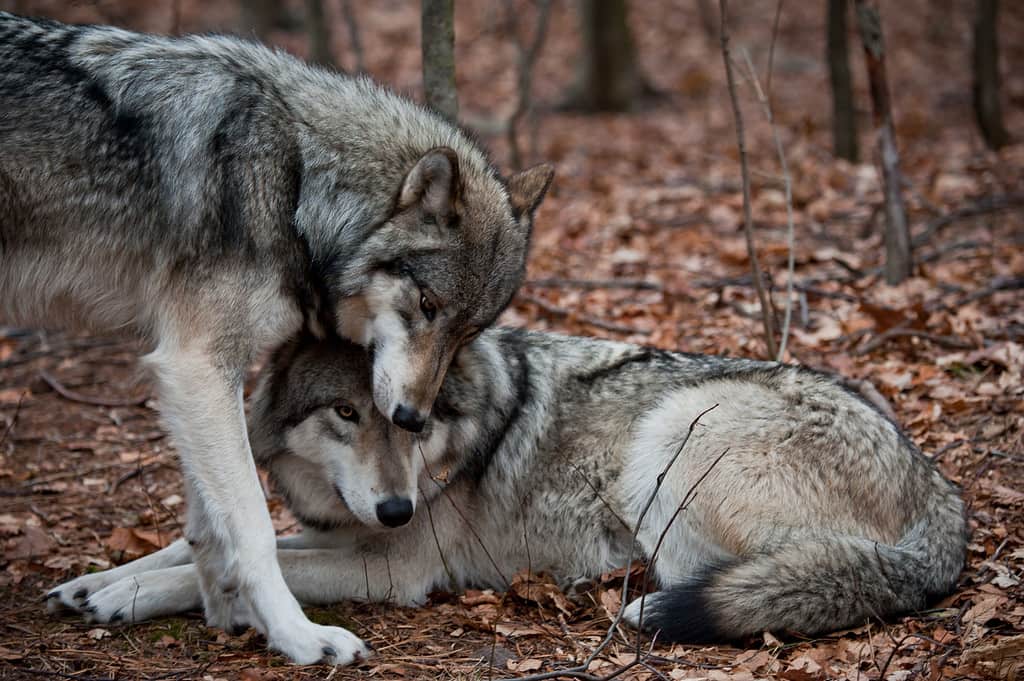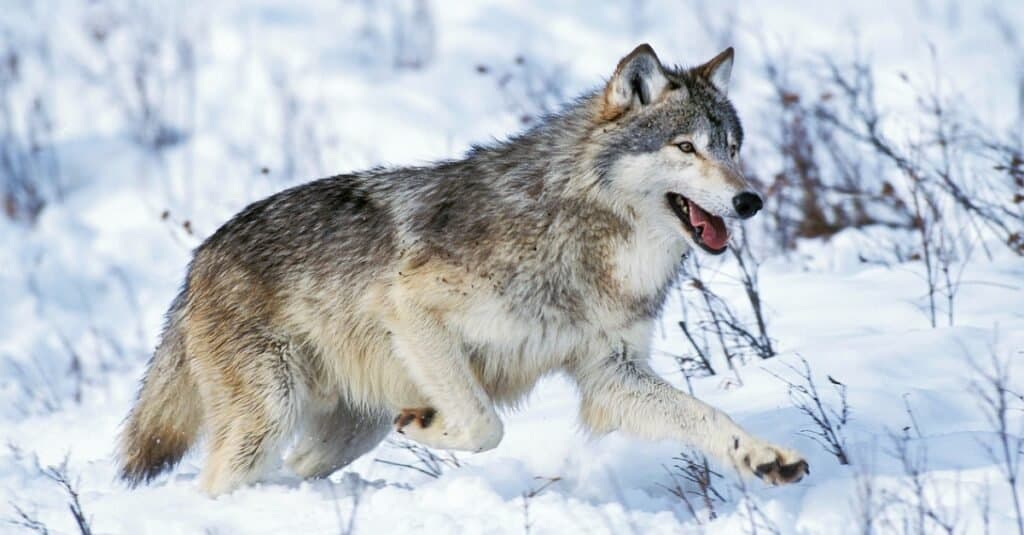Wolves have not always existed in Yellowstone National Park– so much so that there was a process for the reintroduction of wolves to Yellowstone. While the gray wolf is one of the most exciting things to see during your visit to Yellowstone, how did this majestic creature return to the park, and has this return been successful for both the park and the species as a whole?
In this article, we will address the reintroduction of wolves to Yellowstone National Park, including whether or not the process has proven successful. We will also go over the history of wolves in Yellowstone, including when and why reintroduction was necessary in the first place. Let’s get started and talk about the ongoing history of the gray wolf in Yellowstone!
The History of Wolves in Yellowstone National Park

From 1995-1997, Yellowstone Park Rangers and teams of scientists and conservationists introduced 41 wolves into the greater Yellowstone ecosystem.
©iStock.com/rogertrentham
The idea of a balanced ecosystem and food chain was not on anyone’s mind back in the 1800s. Yellowstone National Park first opened in 1872 and visitors were welcomed to explore its vast and varied landscape. Not only were there geysers and waterfalls to explore, but there was wildlife too. Elk, bison, bears, and more roamed this territory, and one other apex predator did too: the gray wolf.
Conservation and protecting animals from extinction was not something anyone considered for some time-decades, even. Up until 1972, gray wolves were not considered endangered, despite being hunted to near-extinction, both in Yellowstone National Park and beyond. In fact, the last wolf pack to live in Yellowstone was hunted as early as the 1920s, leaving a wilderness area without a prime predator for close to 70 years.
A Plan for Reintroduction of Wolves to Yellowstone

Contrary to myths, wolves have no connection to the phases of the moon.
©Alexander Sviridov/Shutterstock.com
However, from 1995-1997, Yellowstone Park Rangers and teams of scientists and conservationists introduced 41 wolves into the greater Yellowstone ecosystem. They took time to ensure that the wolves were ready to be released from large holding pens, and then let them free.
Decades later, the wolf population in the Yellowstone ecosystem is stable. In fact, in 2021, roughly 100 wolves called Yellowstone National Park home, with more than 500 wolves living in the greater Yellowstone ecosystem. However, venturing outside of the boundaries of Yellowstone National Park can prove dangerous, considering the fact that wolves are no longer endangered and are safe to hunt in certain states surrounding Yellowstone. But more on this later.
Why Were Wolves Reintroduced to Yellowstone?

Not only was the reintroduction of wolves into the Yellowstone ecosystem valuable for growing the wolf population, but it became something that visitors could see and marvel at.
©iStock.com/JohnPitcher
Besides the desire to heal the wolf population in the United States due to overhunting, wolves were reintroduced into the Yellowstone ecosystem to create more balance. The elk population in Yellowstone in particular was growing out of control, trampling and consuming vegetation at an alarming rate.
Another argument could be made that wolves were reintroduced into Yellowstone National Park as a tourism play. The wolves of Yellowstone are famous around the world, especially when you consider the fact that it is one of the best locations for viewing gray wolves in their natural habitat on the entire planet.
Wolves Equate to Increased Revenue for the Park

Two grey wolves showing affection
©RamiroMarquezPhotos/iStock via Getty Images
Not only was the reintroduction of wolves into the Yellowstone ecosystem valuable for growing the wolf population, but it became something that visitors could see and marvel at. As the wolf population grew, so did tourism. Yellowstone National Park estimates that roughly $20-30 million of revenue is generated in the region based solely on wolf viewing activity and interest.
However, as wolves leave the endangered species list, so does their protection. Wolves are legally hunted in the states surrounding Yellowstone National Park, mostly out of necessity and protection of cattle farms or homesteads. The population has proved stable enough to merit a certain number of wolf deaths in the region- so does this mean the reintroduction of wolves to Yellowstone has been successful?
Has the Reintroduction of Wolves to Yellowstone Been Successful?

Many big game hunters are frustrated by the increased wolf population in the Yellowstone area.
©iStock.com/slowmotiongli
In many ways, the reintroduction of wolves to Yellowstone National Park has been wildly successful. Not only is the population thriving, but equilibrium has returned to many parts of the park. The elk population has decreased, leading to an increase in vegetation and beautiful surroundings. Other animal populations have increased as well, including beavers.
Given the unique and expansive ways in which wolves claim territory, the elk populations have not only decreased, but their numbers are more evenly distributed throughout the park. Wolves directly influence the movement and behavior of herbivores in Yellowstone, leading to predictable patterns and more peace in the park overall.
Hunting and Wolf Population

Hunter with dog on the winter hunting
©juliazara/ via Getty Images
Not everyone considers the reintroduction of wolves to Yellowstone Park to be a good thing. Not only are wolf populations in the greater Yellowstone ecosystem experiencing threats from local ranchers, but they are also coming under fire from hunters. Many big game hunters are frustrated by the increased wolf population in the Yellowstone area because it means that there are fewer elk to hunt compared to how things were before the reintroduction.
While this is an important notion, many findings illustrate that the Yellowstone wolf population has declined by roughly 20% due to hunting outside of Yellowstone National Park. This is largely due to a recent decision to remove wolf hunting quotas in two northern locations outside Yellowstone. Rather than only being able to hunt a single wolf in these areas, there is no limit.
For Yellowstone National Park and the gray wolf population in general, the reintroduction of wolves into the Yellowstone ecosystem has been a success. However, as the view of wolves still remains largely negative and as human influence continues in the region, there are likely people who disagree with this statement.
No matter the case, viewing wolves in Yellowstone National Park is unlike anything else and wouldn’t have been possible without this reintroduction program!
The photo featured at the top of this post is © Paul Aparicio/Shutterstock.com
Thank you for reading! Have some feedback for us? Contact the AZ Animals editorial team.






